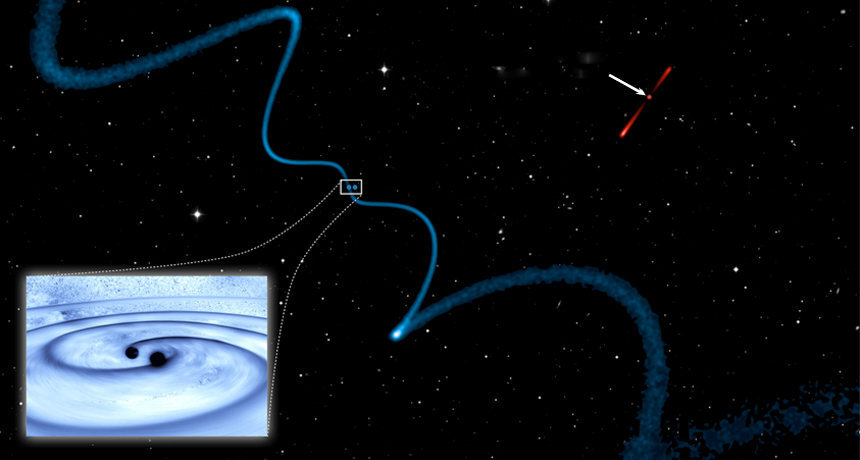
THREE’S A CROWD Three supermassive black holes, seen in an artist’s illustration, include two only 450 light-years apart (blue), with electron jets streaming out in spirals. The third black hole (red) sits 24,000 light-years away and produces straight jets.
R. Deane, NASA Goddard
- More than 2 years ago
Where two distant galaxies collide, three supermassive black holes engage in a gravitational dance. Two of the black holes embrace in a tight orbit, spinning out jets of gas, while the third waits off to the side. Observations of the trio demonstrate that swirling jets can help astronomers find hidden black hole pairs. The finding also suggests that these pairs may be more common than previously thought.
Every large galaxy appears to harbor a central supermassive black hole, a pileup of the corpses of huge stars. These black holes, which can weigh well over a billion suns, appear to build up over time from collisions between galaxies. As two galaxies merge, their central black holes find one another, spiral together and eventually combine into one giant black hole.
Roger Deane, an astrophysicist at the University of Cape Town in South Africa, and colleagues stumbled upon the black hole trio while studying galaxies that emit a lot of radio light. The researchers knew of a galaxy that holds two black holes, which were first discovered three years ago and are separated by about 24,000 light-years. What Deane’s team figured out is that one of those black holes is actually two black holes, crowded together at just 450 light-years apart, the team reports June 25 in Nature.
To distinguish between the two close-together black holes, Deane’s team used the European Very Long Baseline Interferometry Network. When used together, EVN’s 18 telescopes, spread around the world, behave like a powerful antenna with roughly the diameter of Earth. The network provides astronomers with the resolution needed to pick out the separate blasts of radio waves from two black holes hundreds of light-years apart in a galaxy nearly 5 billion light-years away.
By combining the new observations with old data, Deane and colleagues also saw a spiraling jet of electrons coming from one of the black holes in the closely bound pair. The gravity of one of the black holes appears to be yanking around the other’s jet.
Scientists have seen twirling jets before and thought that they might come from two supermassive black holes orbiting each other, says Hai Fu, an astrophysicist at the University of Iowa in Iowa City, who was part of the team that originally discovered the black holes. But this is the first time astronomers have seen both a spiraling jet and independent evidence of a black hole binary. Now astronomers can use spinning jets to look for black hole pairs that they couldn’t otherwise see.
“I’m quite excited to see that our system has turned out be a triple,” Fu says. Finding dual black holes is hard, he adds. “We spent many years looking at many sources, and this was the only pair we found.”
But Deane’s team’s findings suggest that close binaries are prevalent, since the team found one after looking at only six galaxies. “Either we got incredibly lucky and won the lottery,” Deane says, “or they’re more common than previously anticipated.”
Researchers think that compact binary supermassive black holes may be strong sources of gravitational waves. As they orbit each other, the black holes radiate gravitational energy, which should send out ripples in the fabric of space. In principle, these gravitational waves may be detectable by instruments on Earth, like the European Pulsar Timing Array, but physicists have not directly detected the waves. A direct observation of gravitational waves would confirm a prediction of Einstein’s theory of general relativity and also provide a way to explore the many phenomena that emit almost no light. A collection of compact black hole pairs could help researchers know where to look.
Editor’s Note: This article was updated on June 30, 2014, to provide the correct telescope array that could detect gravitational waves from binary black holes.







